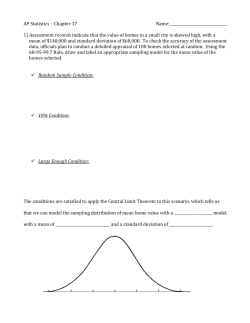
SAMPLING DISTRIBUTIONS
SAMPLING DISTRIBUTIONS
A sampling distribution is the probability distribution for the means of all samples of size n
from a given distribution. The sampling distribution will be normal distributed with
parameters
̅
and
̅,
if either
the population from which the samples are drawn is normally distributed, or
the samples are large (n ≧ 30)
where
𝜇𝑥̅ = μ and 𝜎𝑥̅ =
𝜎
[for large samples]
√𝑛
NB: ⦁ the sampling distribution has the same centre as the population
⦁ the measure of variability of a sampling distribution, ̅ , is called the standard error.
The distribution of means is not as spread out as the values in the population from
which the sample was drawn.
⦁ if we do not know the population standard deviation we approximate with the sample
standard deviation: ̅ ≅ ̅ and
≅
)
√
√
Con ider the little ‘population’ of value P = {1 2 3 4 5}
Thi population ha μ = 3 and = 1.41
If a ample of ize n = 3 wa drawn from thi population it could be any one of…
(1 2 3) (1 2 4) (1 2 5) (1 3 4) (1 3 5) (1 4 5) (2 3 4) (2 3 5) (2 4 5) (3 4 5)
The means of each of the samples, and a histogram of the distribution of means, are shown in
the table and graph below:
Sample
Mean
̅ =2
1
2
3
1
2
4
̅ = 2.33
1
2
5
̅ = 2.67
1
3
4
̅ = 2.67
1
3
5
̅ =3
1
4
5
̅ = 3.33
2
3
4
̅ =3
2
3
5
̅ = 3.33
2
4
5
̅ = 3.67
3
4
5
̅ =4
̿=3
̅ = 0.61
,
The sampling distribution of the means for samples of size 3 is:
P(
= ̅)
2
2.33
2.67
3
3.33
3.67
4
0.1
0.1
0.2
0.2
0.2
0.1
0.1
Even though this sample is small, and the population is not normally distributed (though it is
symmetric) the sampling distribution is reasonably normally distributed:
.2
.15
0
.05
.1
probability
2
2.5
3
Mean
3.5
4
We can see that the mean of the sampling distribution (the mean of all the means) is the same as
the population mean, ̿ = μ = 3. But the variability in the sampling distribution is less than that
of the population: ̅ = 0.61 and = 1.41. Because larger samples, or those drawn from
normally distributed populations, will follow a normal distribution we can use the properties of
normal distributions to find probabilities relating to samples:
̅
=
̅
̅
=
̅
√
Example
The shire of Bondara has 1200 preschoolers. The mean weight of pre-schoolers is known to be
18kg with a standard deviation of 3kg. What is the probability that a random sample of 50
preschoolers will have a mean weight more than 19kg?
n = 50, μ = 18 and = 3
The sampling distribution of the means for samples of size 50 will have
standard error,
̅
̅–
=
̅
=
=
√
Pr ( ̅
=
√
–
√
=
̅
= μ = 18, and
= 0.42.
2.38
√
̅ > 2.38)
= 1 – 0.9913 [from tables]
= 0.0087
1 ) = Pr(
Exercise
1. List all samples of size 2 for the population {1, 2, 3, 4, 5, 6}. What is the probability of
obtaining a sample mean of less than 3?
2.
Samples of size 40 are drawn from a population with μ = 50 and = 5.
(a) What are the mean and standard error of the sampling distribution?
(b) What is the probability that a particular sample has a mean less than 48.5?
3. If IQ in the general population of secondary students is known to follow a normal
distribution with μ = 100 and = 10,
(a) find the mean and standard error for a random samples of size 100.
(b) To test whether a secondary school is representative of the general population a
sample of 100 students from that school is chosen. What is the probability of the
mean IQ being more than 105?
(c) What would be your conclusion?
Answers
1. 3/15 = 1/5
2. (a) ̅ = 50 and
3.
̅
= 0.79 (b) 0.0288
(a) ̅ = 100 and ̅ = 1 (b) 0.00003 (c) either the sample was not random (perhaps all the smartest students were in
the sample) or this school has a higher IQ than the general population.
© Copyright 2025





















